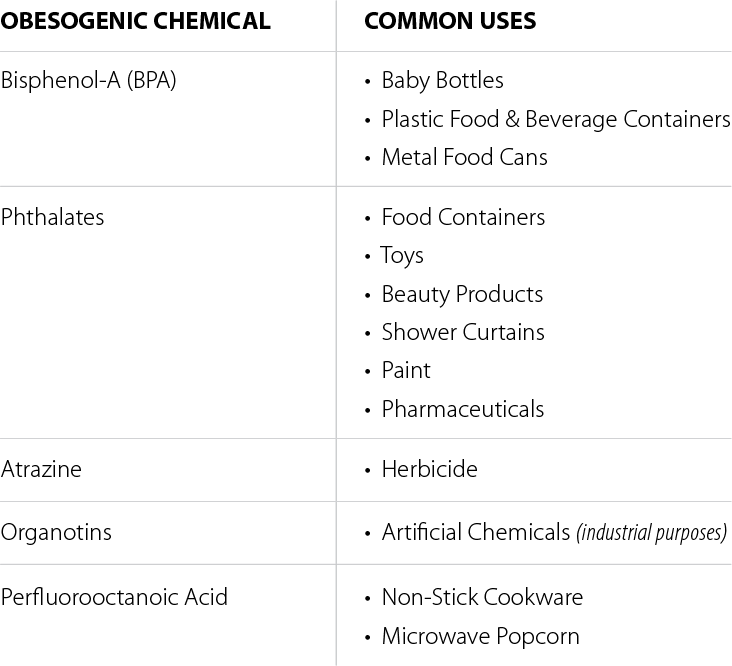Are Obesogens in Household Products Wrecking Your Hormones? Unbeknownst to many, toxins can have a devastating impact on a person’s health. Quite a few of these harmful chemicals are hiding in plain sight. They can be linked to a variety of health issues, including weight gain, diabetes, thyroid disease, and infertility. These obesogenic chemicals are in many of our home and personal care products.
Obesogens in Household Products: What Are Obesogens?
Obesogens are defined as “foreign chemical compounds that disrupt normal development.” They are also defined as chemicals that “alter lipid homeostasis and fat storage, change metabolic set points, disrupt energy balance or modify the regulation of appetite to promote fat accumulation and obesity.”
There are many obesogens currently in use, with the most common being the following:

Studies have linked obesogens in household products to a variety of health issues worldwide:
Weight gain: Individuals exposed to certain substances such as endocrine-disrupting chemicals (EDCs) early in life (or even prenatal exposure) may be predisposed to increased fat mass and excess weight, according to studies.1
Male fertility: Studies indicate obesogens could be linked to a decrease in male fertility due to their action as “endocrine disruptors.”2
Altered reproductive hormone levels in girls: A 2011 study on 239 Taiwanese girls aged 12 and younger found that girls with higher phthalate concentrations had greater odds of sex-hormone-binding globulin above median levels.3
Increased birth defects: Preliminary studies on the obesogen atrazine and other pesticides between 1996 and 2002 found that higher risks of birth defects occurred when there were elevated levels of agrichemicals in surface water.4
Hyperthyroidism: Exposure to the obesogen perfluorooctanoate (PFOA) was found to increase the risk of hypothyroidism. Studies also indicate women and children were more at risk for mild thyroid failure when exposed to the chemical.5
In addition to the studies listed above, some believe environmental chemicals may be the root cause of many chronic health problems seen today, such as autoimmune disorders, skin issues, the inability to lose weight and dozens of other ailments.
The Focus is on Treatment, Rather Than “Root Cause”
Unfortunately, most doctors aren’t discussing the potential effects of being exposed to obesogens. Instead, they focus on treating and alleviating symptoms, without determining what may be causing the mysterious health issues in the first place. As a result, they will never discover the potential link to these chemicals, and risk giving their patients inadequate (and ineffective) treatment.
How Obesogens in Household Products Affect the Body
There are a few ways obesogens affect the body:
Endocrine Disruption
The hormone system regulates the body’s metabolism, energy, hunger and feelings of fullness. Exposure to obesogens can lead to metabolic distress, which could disrupt the endocrine system. For example, when the signals to alert the body of hunger and fullness are altered, a person may continue eating when they are actually full. In time, this could lead to weight gain.
This overeating increases the risk of other health issues such as diabetes, high blood pressure, and coronary heart disease. Medicines are then prescribed to combat these obesity-related ailments, while the actual cause of the weight gain (obesogens) goes undetected and untreated.
PPar Gamma Receptors Activated
The PPar receptor is a type II nuclear receptor that is encoded by the PPARG gene in humans. This receptor is our master regulator of fat cell development. When activated, it causes one or two things to happen: If this PPar gamma is activated and a cell is in predevelopment, it starts out as a stem cell but converts to a fat cell.
These newly created fat cells begin to increase in size and capacity, allowing them to become containers for more toxins.
Obesogens in Household Products: Decreasing Obesogen Exposure
Identifying top sources of obesogen is a critical first step in improving a person’s health. Obesogens are found in more than just household products. Here are a few tips on reducing exposure to this dangerous chemical:
Eat Organic Fruits and Vegetables:
Many of the pesticide residues on conventional fruits and veggies contain obesogens. Switching to organic varieties can have an immediate impact on decreasing the levels of obesogens in the body.
Avoid Home Fragrances:
Scented candles, air fresheners, plugins and other types of home fragrances all contribute to indoor air pollution. According to the EPA, scientific evidence indicates indoor air can be “more seriously polluted” than the outdoor air in even the largest and most industrialized cities.6
Eliminate Fabric Softeners:
The toxins in fabric softeners can be inhaled and absorbed through the skin via clothes, bed sheets, etc.
Decrease the Use of Plastics:
The plastics that come into contact with food can leach obesogenic compounds into the food. This also includes plastic water bottles, plastic utensils, drinking cups, plates, and other plastic kitchen items. Each of these items should be avoided. (The use of microwaves increases the leaching as well.) Plastics also contain synthetic estrogen, which contributes to hormonal disruption. Instead of storing most foods in plastic, opt for glass containers and mason jars.
Note: plastic containers can be used for foods like pretzels, and non-food items, such as storage for items in the garage.
Filter Drinking Water:
Even though the Safe Water Drinking Act regulates 91 contaminates, tap water containing lead is still a serious problem in Flint, Michigan and countless other cities
Opt For a Natural Deodorant:
There’s a big difference between antiperspirants and deodorants: People like antiperspirants because it eliminates sweaty armpit stains. However, antiperspirants contain compounds that are intended to block the sweat glands. Small gel plugs were created to literally block sweat glands.
This is important because sweating is one of the ways toxins are removed from the body. These ingredients also have fragrances, which means they contain synthetic chemicals like phthalates and parabens which is another endocrine disruptor. For this reason, using deodorants may be a healthier option.
Fortunately, there are many non-toxic deodorants to choose from that do not have these synthetic compounds.
Putting it All Together
Obesogens in household products are used in many facets of modern life. While removing these harmful chemicals may seem daunting, it should be viewed as a systematic phase-out. It doesn’t have to be done overnight or on a weekend. It may take several months or longer, but even the smallest changes can have a tremendous impact on a person’s health over time.
Toxicity expert Lara Adler shares more details about the topic of ‘Obesogens’ in this eye-opening interview. Drinking water is a shocking source of daily toxins, and Lara has an e-course on finding the best filters for the purest water. Learn what the most common contaminants in drinking water are, what health issues they are associated with, and be equipped to be more intentional with your daily intake of water.
References:
- Roya Kelishadi, Parinaz Poursafa, and Fahimeh Jamshidi, Role of Environmental Chemicals in Obesity: A Systematic Review on the Current Evidence. Journal of Environmental and Public Health, vol. 2013, Article ID 896789, 8 pages, 2013. https://doi.org/10.1155/2013/896789.
- Cardoso AM, Alves MG, Mathur PP, (et al.) Obesogens and Male Fertility. Published online. 2017 Jan;18(1):109-125. [doi: 10.1111/obr.12469.] Epub 2016 Oct 24. PMID: 27776203 DOI: 10.1111/obr.12469 https://www.ncbi.nlm.nih.gov/pubmed/27776203
- Wen HJ, Chen CC, Wu MT (et al.) Phthalate Exposure And Reproductive Hormones And Sex-Hormone Binding Globulin Before Puberty – Phthalate Contaminated-Foodstuff Episode In Taiwan. PLoS One. Published online. 2017 Apr 14;12(4):e0175536. [doi: 10.1371/journal.pone.0175536.] eCollection 2017. PMID: 28410414 PMCID: PMC5391940https://www.ncbi.nlm.nih.gov/pubmed/28410414
- Winchester PD, Huskins J, Ying J. Agrichemicals In Surface Water And Birth Defects In The United States. Acta Paediatr. Published online. 2009 Apr;98(4):664-9. [doi: 10.1111/j.1651-2227.2008.01207.x.] Epub 2009 Jan 22.https://www.ncbi.nlm.nih.gov/pubmed/19183116
- Coperchini F, Awwad O, Rotondi M Thyroid Disruption By Perfluorooctane Sulfonate (PFOS) And Perfluorooctanoate (PFOA). J Endocrinol Invest. Published online. 2017 Feb;40(2):105-121.[ doi: 10.1007/s40618-016-0572-z.] Epub 2016 Nov 11.https://www.ncbi.nlm.nih.gov/pubmed/27837466
- The Inside Story: A Guide to Indoor Air Quality. https://www.epa.gov/indoor-air-quality-iaq/inside-story-guide-indoor-air-quality


